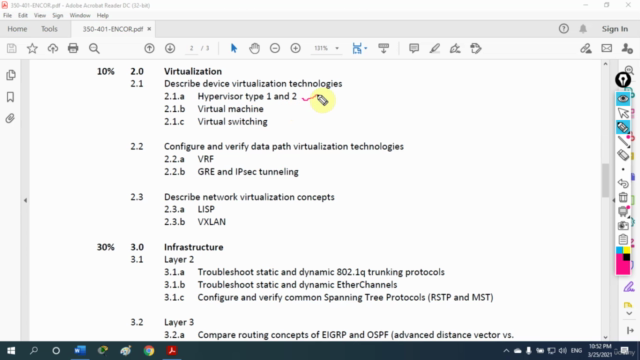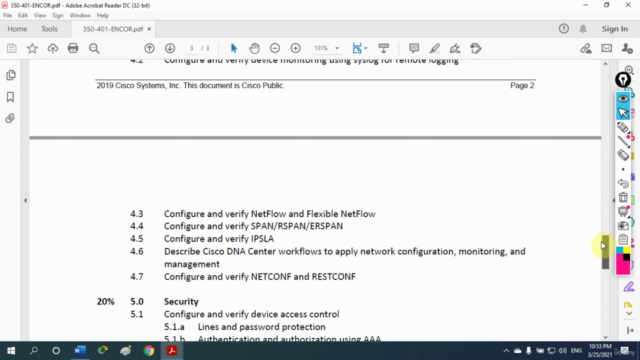CCNP,CCIE Enterprise: ENCOR 350-401 v1.1 Training

Why take this course?
1-50. These topics cover a range of fundamental networking concepts, including different types of OSPF networks, which are essential for understanding how OSPF operates in various network topologies.
51-60. These topics delve into more specific aspects of OSPF, such as its behavior in non-broadcast multi-access (NBMA) networks, point-to-point and point-to-multipoint configurations, multi-area OSPF setups, and load balancing strategies.
61-70. These topics cover advanced OSPF configurations like summarization, passive interfaces, filtering, and path selection, which are crucial for efficient routing in large networks.
71-80. EIGRP is another premier distance vector routing protocol used primarily in Cisco environments. These topics cover the configuration, metrics, path selection optimization, and various types of EIGRP packets, as well as first hop redundancy protocols like HSRP, VRRP, and SSO.
81-90. Network security is a broad topic that includes access control lists (ACL), network address translation (NAT), policy-based routing (PBR), and quality of service (QoS) to ensure secure and efficient traffic flow within the network.
91-100. These topics cover enterprise networking, virtualization, VRFs, time synchronization with NTP, and various VPN technologies, including GRE tunnels.
101-110. Border Gateway Protocol (BGP) is the routing protocol for the Internet and these topics cover its fundamental concepts to advanced configurations like neighbor states, timers, route reflection, path attributes, and security aspects like AS path prepending and MED manipulation.
111-120. Network security design, IPSLA for performance testing, LISP, VXLAN, and wireless networking are all areas that have become increasingly important in modern networks due to their ability to scale, optimize performance, and secure the network infrastructure.
121-135. These topics include advanced security measures like COPP (Cisco Outbound Packet Inspection), Rest API security for automation and programmability, and wireless security features like EAPOL and client density metrics.
136-140. Automation is becoming a critical component of modern network management. These topics cover the principles and practical implementation of automation using REST APIs, Netconf, and Restconf, along with AAA (Authentication, Authorization, and Accounting) for securing network access.
141-149. Performance routing, like PBR, and advanced topics like the benefits and limitations of SD-WAN technologies are covered here, rounding out the list with a focus on optimizing network performance and understanding the complexities of modern network architectures.
These topics are designed to provide a comprehensive understanding of networking from the ground up, covering everything from basic protocols and configurations to advanced routing techniques, security measures, and automation strategies. Each topic builds upon the previous ones to create a cohesive understanding of how networks operate and what considerations must be made to manage them effectively.
Course Gallery




Loading charts...